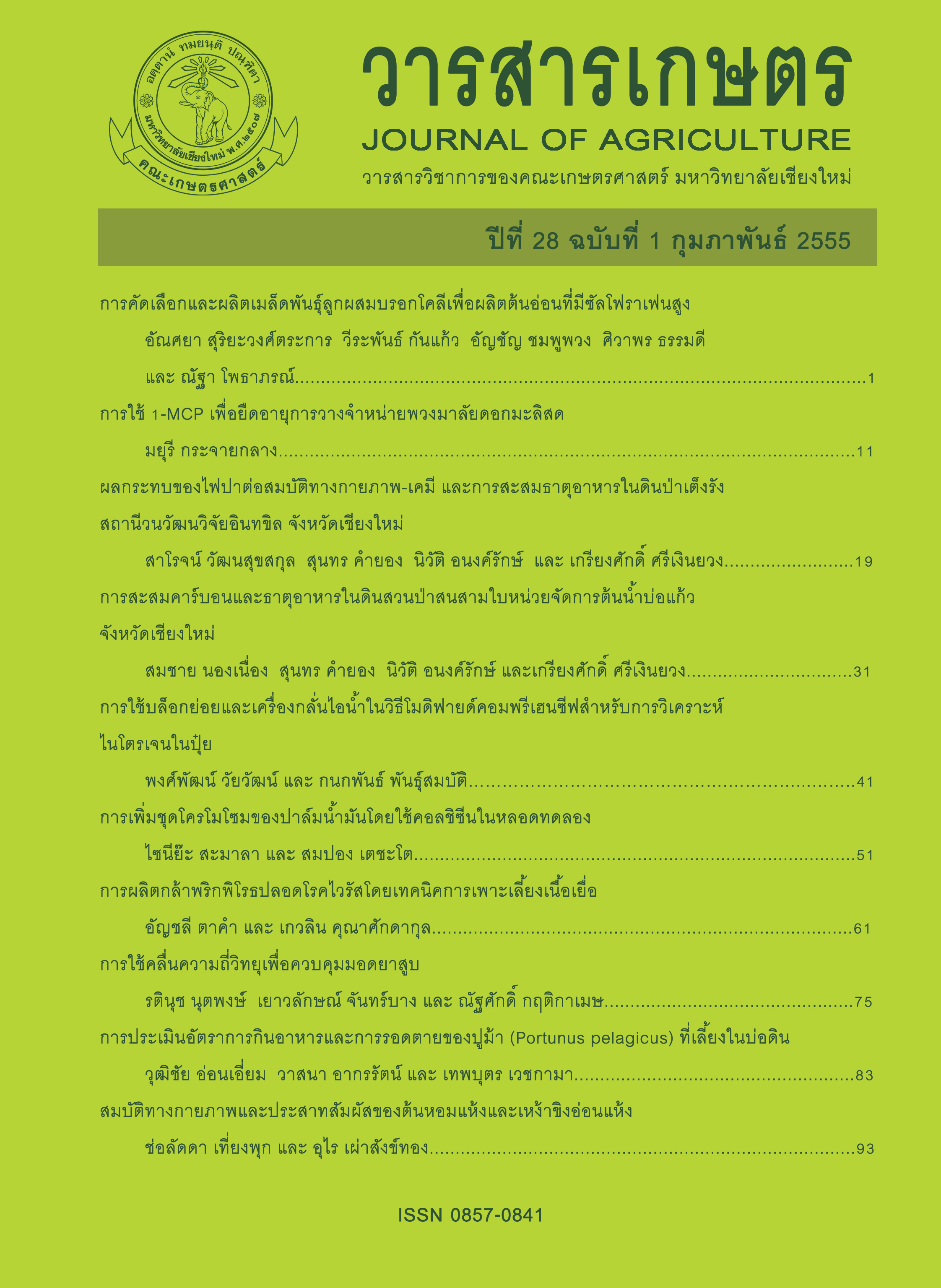สมบัติทางกายภาพและประสาทสัมผัสของต้นหอมแห้งและเหง้าขิงอ่อนแห้ง
Main Article Content
บทคัดย่อ
ศึกษาการทำแห้งต้นหอม และเหง้าขิงอ่อน โดยวางแผนการทดลองแบบ CRD ประกอบด้วย 2 สิ่งทดลอง คือ นึ่ง (ต้นหอมนึ่ง 1 นาที และขิงอ่อนนึ่ง 2 นาที) และไม่นึ่ง ก่อนนำไปอบแห้งโดยใช้ตู้อบลมร้อนอุณหภูมิ 50 °Cจนตัวอย่างมีค่า aW < 0.6 นำผลิตภัณฑ์มาหาปริมาณผลผลิต วัดสี ค่า water activity (aW) อัตราการคืนตัว และนำมาคืนตัวเพื่อทดสอบทางประสาทสัมผัสแบบความชอบ ทดสอบกับผู้ชิม 30 คน โดย 1-7 hedonic scaling วิเคราะห์ข้อมูลด้วย Excel ที่ระดับนัยสำคัญ 0.05 ผลการทดลองพบว่าการต้นหอมและขิงนึ่งมีสีเข้มกว่า ส่วนค่า aW และอัตราการคืนตัวไม่ต่างกัน และผู้ชิมชอบต้นหอม และขิงไม่นึ่งมากกว่า โดยเฉพาะ สี เนื้อสัมผัส และกลิ่นรส
Article Details
ประเภทบทความ
บทความวิจัย
เอกสารอ้างอิง
กุลวดี ตรองพาณิชย์ ช่อลัดดา เที่ยงพุก และสิริพร สธนเสาวภาคย์. 2548. การพัฒนาและถ่ายทอดเทคโนโลยีการผลิตผลิตภัณฑ์พริกในภาชนะบรรจุสู่เชิงพาณิชย์. รายงานวิจัยฉบับสมบูรณ์ สถาบันค้นคว้าและพัฒนาผลิตภัณฑ์อาหาร มหาวิทยาลัยเกษตรศาสตร์ กรุงเทพฯ 58 หน้า.
กำพล ศรีประเสริฐ และเมธี พันนุรัตน์. 2539. เครื่องอบแห้งขิง. ปริญญาตรีวิศวกรรมบัณฑิต, มหาวิทยาลัยเชียงใหม่. 60 หน้า.
คณะทำงานรวบรวมความรู้เกี่ยวกับผัก. 2541. มหัศจรรย์ผัก 108 ครั้งที่ 2 โครงการหนูรักผักสีเขียวโดยความร่วมมือระหว่างมูลนิธิโตโยต้าประเทศไทย. สายส่งศึกษิต บริษัทเคล็ดไทย กรุงเทพฯ. 411 หน้า.
สมชาติ โสภณรณฤทธิ์ และสมเกียรติ ปรัชญาวรากร. 2537. แนวทางการอบแห้งต้นหอมสับ. วิทยาสารเกษตรศาสตร์ สาขาวิทยาศาสตร์ 28 (4): 602-607.
วิชัย เพชรดาษดา. 2540. วิทยานิพนธ์ (วศ.ม. เทคโนโลยีการจัดการพลังงาน) มหาวิทยาลัยเทคโนโลยีพระจอมเกล้าธนบุรี, กรุงเทพฯ. 89 หน้า.
วินัย ดะลันห์. 2547. อาหารต้านอนุมูลอิสระ เนชั่นสุดสัปดาห์ 13 (646-653)
Balladin, D.A., O. Headley, I. Chang-Yen and D.R. McGaw. 1998. High pressure liquid chromatographic analysis of the main pungent principles of solar dried West Indian ginger (Zingiber officinale Roscoe). Renewable Energy 13 (4): 531-536.
Champagne, E, J.A. Liuzzo, R.M. Rao and D.A. Smith. 1985. Chemical treatment and Process modification for producing improved quick-cooking rice. Journal of Food Science 50: 926-931.
Chen, C.C., R.T. Rosen and C.T. Ho. 1986. Chromatographic analyses of isomeric shogaol compounds derived from isolated gingerol compounds of ginger (Zingiber officinale Roscoe). Journal of Chromatography 360: 175-184.
Deliza, R., A. Rosenthal, F.B.D. Abadio, C.H.O. Silva and C. Castillo. 2005. Application of high pressure technology in the fruit juice processing: Benefits perceived by consumers. Journal of Food Engineering 67: 241-246.
Govindarajan, V.S. 1982. Ginger - chemistry, technology and quality evaluation: Part 1. Critical Reviews in Food Science and Nutrition 17: 1-257.
Hoover, D.G. 1997. Minimally processed fruits and vegetables: Reducing microbial load by nonthermal physical treatments. Food Technology 51 (6): 66-69.
Kendall, P., P. DiPersio and J. Sofos. 2010. Drying vegetables. (Online) Available: http://www.ext.colostate.edu/pubs/foodnut/09308.html (July 30, 2011)
McGee, H. 2004. A survey of tropical spices. McGee on Food and Cooking. Hodder and Stoughton. p. 426.
Nicoli, M.C., B.E. Elizalde, A. Pitotti and C.R. Lerici. 1991. Effect of sugars and maillards reaction products on polyphenol oxidase and peroxidase activity in food. Journal of Food Biochemistry 15: 169–184.
Phoungchandang, S. 2009. Simulation model for heat pump dehumidified air drying for some herbs. World Journal of Agricultural Sciences 5 :138-142.
Purseglove, J.W. 1972. Tropical Crop, Monocotyledons 2. Longmans, London. 607 pp.
Rabinowitch H.D. and L. Currah. 2002. Allium Crop Science: Recent Advances CABI Publishing. 515 pp.
Rocha, T., A. Lebert and C. Marty-Audouin. 1993. Effect of Pretreatments and drying conditions on drying rate and colour retention of Basil (Ocimum basilicum). LWT-Food Science and Technology 26 (5): 456 463.
Schweiggert, U., M. Klaus, S. Andreas and C. Reinhold. 2005. An innovative process for the production of spices through immediate thermal treatment of the plant material. Innovative Food Science and Emerging Technologies 6 (2): 143-153.
Wohlmuth, H., D.N. Leach, M.K. Smith and S.P. Myers. 2005. Gingerol content of diploid and tetraploid clones of ginger (Zingiber officinale Roscoe). Journal of Agricultural and Food Chemistry 53: 5772-5778.
Yogeshwer, S. and S. Madhulika. 2007. Cancer preventive properties of ginger: a brief review. Journal of Food Science 45: 683 - 690.
กำพล ศรีประเสริฐ และเมธี พันนุรัตน์. 2539. เครื่องอบแห้งขิง. ปริญญาตรีวิศวกรรมบัณฑิต, มหาวิทยาลัยเชียงใหม่. 60 หน้า.
คณะทำงานรวบรวมความรู้เกี่ยวกับผัก. 2541. มหัศจรรย์ผัก 108 ครั้งที่ 2 โครงการหนูรักผักสีเขียวโดยความร่วมมือระหว่างมูลนิธิโตโยต้าประเทศไทย. สายส่งศึกษิต บริษัทเคล็ดไทย กรุงเทพฯ. 411 หน้า.
สมชาติ โสภณรณฤทธิ์ และสมเกียรติ ปรัชญาวรากร. 2537. แนวทางการอบแห้งต้นหอมสับ. วิทยาสารเกษตรศาสตร์ สาขาวิทยาศาสตร์ 28 (4): 602-607.
วิชัย เพชรดาษดา. 2540. วิทยานิพนธ์ (วศ.ม. เทคโนโลยีการจัดการพลังงาน) มหาวิทยาลัยเทคโนโลยีพระจอมเกล้าธนบุรี, กรุงเทพฯ. 89 หน้า.
วินัย ดะลันห์. 2547. อาหารต้านอนุมูลอิสระ เนชั่นสุดสัปดาห์ 13 (646-653)
Balladin, D.A., O. Headley, I. Chang-Yen and D.R. McGaw. 1998. High pressure liquid chromatographic analysis of the main pungent principles of solar dried West Indian ginger (Zingiber officinale Roscoe). Renewable Energy 13 (4): 531-536.
Champagne, E, J.A. Liuzzo, R.M. Rao and D.A. Smith. 1985. Chemical treatment and Process modification for producing improved quick-cooking rice. Journal of Food Science 50: 926-931.
Chen, C.C., R.T. Rosen and C.T. Ho. 1986. Chromatographic analyses of isomeric shogaol compounds derived from isolated gingerol compounds of ginger (Zingiber officinale Roscoe). Journal of Chromatography 360: 175-184.
Deliza, R., A. Rosenthal, F.B.D. Abadio, C.H.O. Silva and C. Castillo. 2005. Application of high pressure technology in the fruit juice processing: Benefits perceived by consumers. Journal of Food Engineering 67: 241-246.
Govindarajan, V.S. 1982. Ginger - chemistry, technology and quality evaluation: Part 1. Critical Reviews in Food Science and Nutrition 17: 1-257.
Hoover, D.G. 1997. Minimally processed fruits and vegetables: Reducing microbial load by nonthermal physical treatments. Food Technology 51 (6): 66-69.
Kendall, P., P. DiPersio and J. Sofos. 2010. Drying vegetables. (Online) Available: http://www.ext.colostate.edu/pubs/foodnut/09308.html (July 30, 2011)
McGee, H. 2004. A survey of tropical spices. McGee on Food and Cooking. Hodder and Stoughton. p. 426.
Nicoli, M.C., B.E. Elizalde, A. Pitotti and C.R. Lerici. 1991. Effect of sugars and maillards reaction products on polyphenol oxidase and peroxidase activity in food. Journal of Food Biochemistry 15: 169–184.
Phoungchandang, S. 2009. Simulation model for heat pump dehumidified air drying for some herbs. World Journal of Agricultural Sciences 5 :138-142.
Purseglove, J.W. 1972. Tropical Crop, Monocotyledons 2. Longmans, London. 607 pp.
Rabinowitch H.D. and L. Currah. 2002. Allium Crop Science: Recent Advances CABI Publishing. 515 pp.
Rocha, T., A. Lebert and C. Marty-Audouin. 1993. Effect of Pretreatments and drying conditions on drying rate and colour retention of Basil (Ocimum basilicum). LWT-Food Science and Technology 26 (5): 456 463.
Schweiggert, U., M. Klaus, S. Andreas and C. Reinhold. 2005. An innovative process for the production of spices through immediate thermal treatment of the plant material. Innovative Food Science and Emerging Technologies 6 (2): 143-153.
Wohlmuth, H., D.N. Leach, M.K. Smith and S.P. Myers. 2005. Gingerol content of diploid and tetraploid clones of ginger (Zingiber officinale Roscoe). Journal of Agricultural and Food Chemistry 53: 5772-5778.
Yogeshwer, S. and S. Madhulika. 2007. Cancer preventive properties of ginger: a brief review. Journal of Food Science 45: 683 - 690.


